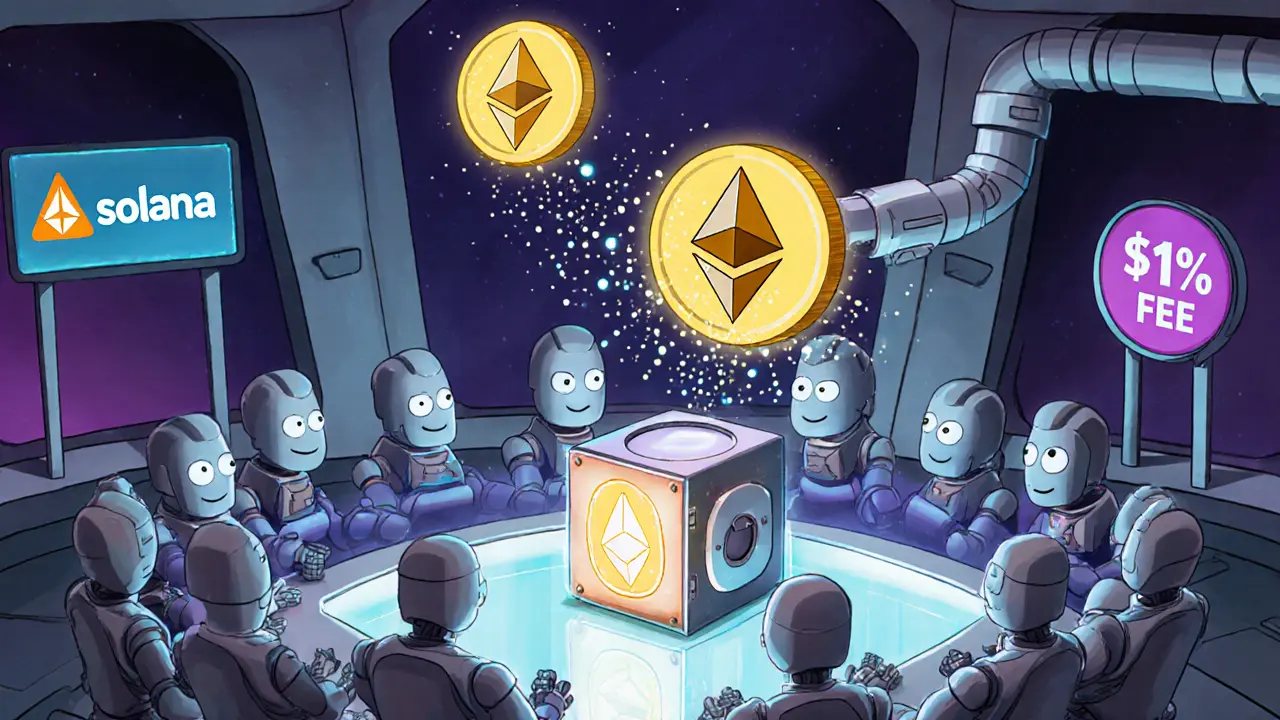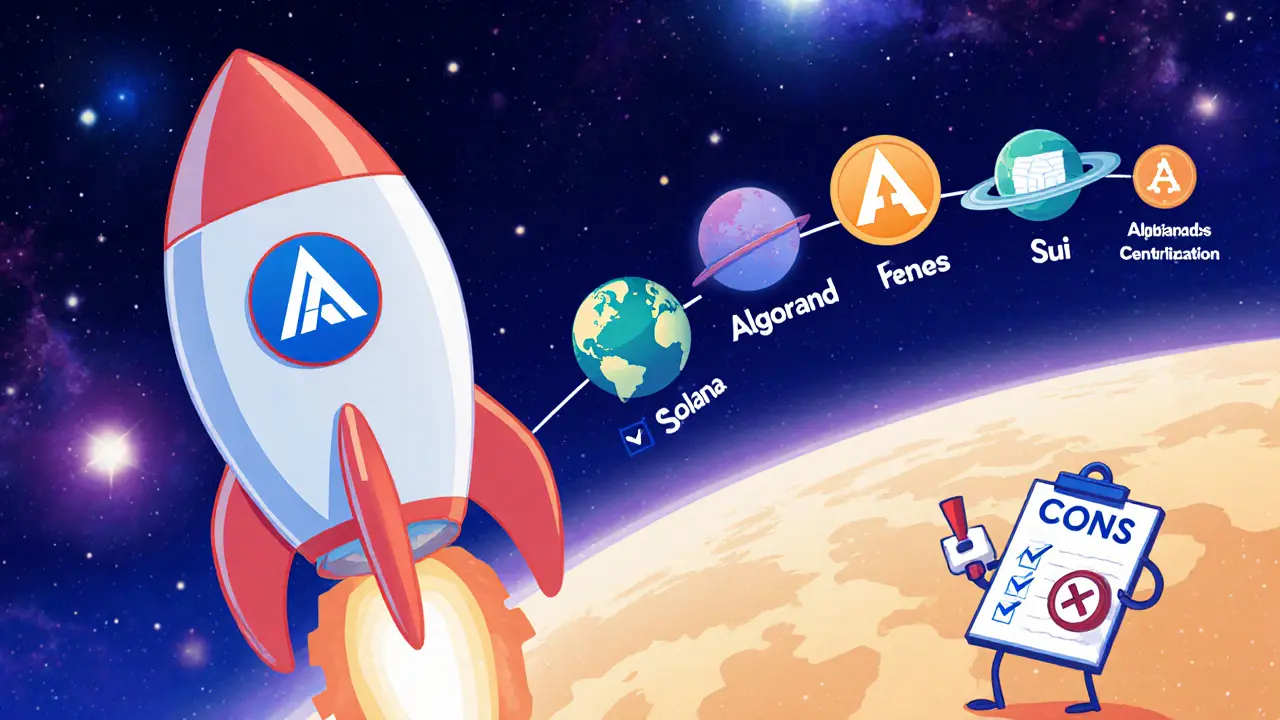Allbridge Fee Calculator
Calculate Your Transaction Cost
Allbridge charges a $1 base fee. Stake ABR tokens to get up to 50% discount.
Estimated Cost
$1.00
Looking for a way to move tokens between Ethereum, Solana, Polygon or other blockchains without paying a fortune? Allbridge is a cross‑chain bridge that lets you transfer assets across 15 EVM and non‑EVM networks for a flat $1 base fee. In this guide you’ll learn how the bridge works, what the ABR token does, which chains are supported, and which pitfalls to watch out for.
Quick Takeaways
- Allbridge supports 15 chains, including Ethereum, Polygon, Solana and Stellar.
- The ABR token can be staked to cut bridge fees by up to 50%.
- Base fee is $1; no hidden costs, but small transfers (<$50) become pricey.
- Security is backed by three audits (Hacken, Kudelski, Cossack Labs) and a validator set of 23 nodes.
- Best for moving medium‑sized amounts between EVM and non‑EVM chains, especially Solana‑Ethereum swaps.
What Is Allbridge (ABR)?
Allbridge is a decentralized bridge platform launched in 2021. It offers two implementations: Allbridge Core for stable‑coin transfers and Allbridge Classic for any ERC‑20 or SPL token. The native utility token, ABR, powers fee discounts and future governance.
Supported Blockchains
The bridge connects both EVM‑compatible and non‑EVM networks. Key chains include:
- Ethereum (Mainnet, Goerli)
- Polygon
- BNB Chain
- Solana
- Stellar
In total, fifteen chains are live as of October2023, making Allbridge one of the few bridges that truly span EVM and non‑EVM ecosystems.
How the Bridge Works
Allbridge uses a mint‑and‑burn model combined with on‑chain validator consensus. The process differs slightly between Core and Classic:
- Source chain lock: The user sends the original token to a smart contract on the source network. The contract emits an event.
- Validator verification: A decentralized set of 23 validators observes the event, reaches consensus, and signs a proof.
- Destination mint: On the target chain, a counterpart contract mints a wrapped version of the asset, crediting the user’s address.
- Reverse flow: When moving back, the wrapped token is burned and the original is released on the source chain.
Allbridge Classic requires two separate transactions (one on each chain) while Core can settle in a single step for supported stablecoins, shaving seconds off the overall time.

ABR Token Utility
The ABR token serves two core purposes:
- Fee discounts: Staking 1,000ABR reduces the flat $1 fee by 0.5%, up to a maximum 50% reduction at 100,000ABR.
- Governance: Future DAO proposals (e.g., adding new chains or adjusting fee structures) will be voted on by ABR holders.
Current circulating supply is about 20millionABR, with a market cap near $1.4million (price≈$0.068 as of Oct2023).
Fees, Costs & Staking Mechanics
The base fee is a flat $1 per transfer, regardless of amount or destination. This is lower than the industry average of $1.85, but it can feel steep for tiny moves. Users can lower the fee by staking ABR directly on the bridge UI or via the official staking contract.
Staking steps:
- Connect a compatible wallet (MetaMask for EVM, Phantom for Solana).
- Navigate to the “Stake ABR” page.
- Enter the amount you wish to lock and confirm the transaction.
- After the transaction confirms, your fee discount applies automatically to subsequent bridges.
Staked ABR can be withdrawn after a 7‑day unbonding period, at which point the discount reverts.
Security Overview
Allbridge has undergone three major audits:
- Hacken (March2022) - fixed 12 critical vulnerabilities.
- Kudelski Security (June2022) - confirmed robust validator logic.
- Cossack Labs (August2022) - validated mint‑and‑burn safety.
Since mainnet launch in April2022 the bridge has not suffered any successful exploits. However, analysts note that 65% of validation power is concentrated in five entities, raising centralization concerns.
Performance Metrics
Typical transfer times range from 2‑5minutes between Ethereum and Solana under normal network conditions. Throughput caps at roughly 15transactions per minute, as measured in a July2023 stress test. Congestion on the source or destination chain directly affects speed-Ethereum spikes can push completion to 10‑12minutes.
Allbridge vs. Major Competitors
| Feature | Allbridge | Wormhole | Multichain |
|---|---|---|---|
| Supported Chains | 15 (EVM+non‑EVM) | 14 (incl. Solana, but no full EVM‑non‑EVM) | 40+ (EVM only) |
| Base Fee | $1 (discountable) | $1.20 - $2.50 | $1.85 avg. |
| TVL (Sept2023) | $4.7M (14th rank) | $420M | $1.2B |
| Security Audits | 3 independent audits | 2 audits, 2022 breach ($325M loss) | 1 audit, no major breach |
| Best Use‑Case | Solana↔EVM transfers | Fast swaps, but higher risk | Broad EVM ecosystem |
Allbridge shines when you need reliable Solana‑Ethereum moves, while Wormhole offers more chains at the cost of higher security risk. Multichain dominates sheer volume but cannot bridge to non‑EVM networks.

Pros & Cons
| Pros | Cons |
|---|---|
| Native Solana support, low base fee, fee‑reduction staking, audited contracts. | Limited chain count, validator centralization, $1 minimum fee makes tiny transfers pricey. |
Step‑By‑Step: Making Your First Transfer
- Open the Allbridge web UI (allbridge.io) and click “Connect Wallet”. Choose MetaMask for Ethereum or Phantom for Solana.
- Select the source chain, destination chain, and the token you want to bridge.
- Enter the recipient address on the destination chain and the amount.
- Review the $1 fee (or discounted fee if you staked ABR) and confirm the transaction.
- Watch the status bar; the bridge will show “Locked”, “Validated”, then “Minted”. Once “Completed”, the tokens appear in your destination wallet.
The whole flow usually takes under 5minutes for a smooth network. If you hit a “failed” status, refer to the troubleshooting guide: check gas fees, make sure the address format matches the target chain, and retry during lower congestion.
Common Pitfalls & How to Avoid Them
- Wrong address format: Solana uses base‑58, Ethereum uses hex. Double‑check before confirming.
- Insufficient gas on source chain: Keep extra ETH or BNB in the wallet to cover transaction fees.
- Network congestion: During peak hours on Ethereum, fees can spike and confirmations delay. Consider using a slower time window or bridging via Polygon if possible.
- Low‑value transfers: Because of the $1 fee, moving <$50 may not be cost‑effective. Consolidate multiple small amounts into a larger batch.
Future Roadmap
Allbridge 2.0 rolled out in August2023, adding batch transactions and a smoother Solana experience. The Q22024 roadmap promises integration with Aptos, Sui, Near, Algorand, and Cosmos, plus a full DAO governance layer slated for March2024. A specialized stablecoin bridge module is in alpha testing, which could push TVL higher.
Frequently Asked Questions
What chains can I bridge with Allbridge?
Allbridge currently supports 15 chains, including Ethereum, Polygon, BNB Chain, Solana, Stellar, Avalanche, Fantom, and others. The list grows as new integrations are announced.
How does staking ABR lower my bridge fee?
For every 1,000ABR you lock in the staking contract, the $1 base fee drops by 0.5%. The maximum discount is 50% once you stake 100,000ABR.
Is Allbridge safe to use?
The bridge has passed three independent security audits and has not suffered a successful exploit since launch. The main risk is validator centralization; five entities control most validation power.
What is the typical transfer time?
Under normal network conditions, moving assets between Ethereum and Solana takes 2‑5minutes. Congested periods can push it to 10‑12minutes.
Can I bridge NFTs with Allbridge?
Allbridge Classic supports ERC‑721 and SPL NFTs, but the process requires extra approvals and higher gas on the source chain. Users should test with a low‑value NFT first.


Comments
So Allbridge tacks on a flat $1 fee, right? That’s kinda cheap compared to some bridges that charge a percentage of the amount. If you’re moving just $10, that $1 is a hefty 10% bite, but on a $1,000 transfer it’s barely noticeable. The staking discount slashing it to 50 cents is a nice perk if you already hold ABR. Overall, the fee structure is simple enough for most users.
Totally agree, but let’s unpack the jargon a bit: the $1 base fee is essentially a “network relay surcharge” that covers validator gas costs across chains. When you stake ABR, you’re essentially providing liquidity to the bridge’s pooled validators, which justifies that 50% discount. It’s a win‑win for the ecosystem: lower fees for stakers, higher throughput for the network.
The risk angle is often glossed over. Allbridge, like any cross‑chain bridge, is a prime target for exploits. Even though they claim audits, the history of bridge hacks suggests you should never move more than you’re comfortable losing. Also, the fee model doesn’t account for sudden gas spikes on Ethereum, which could make the $1 look deceptive during congestion.
👍 Good point! The volatility in gas prices can indeed skew the perceived cheapness of the $1 fee. But hey, at least the UI is clean and the calculator gives you a quick glance. If you’re just testing the waters, the low barrier to entry is pretty inviting. Keep that optimism alive! 🌟
One must contemplate the ontological implications of a bridge that purports to be both decentralized and fee‑efficient. The architecture, predicated upon a dual‑token staking mechanism, ostensibly aligns incentives across disparate ledgers. Yet, the epistemic asymmetry between validators and end‑users persists, rendering the promised egalitarianism somewhat illusory. In sum, while the quantitative fee reduction is laudable, the qualitative governance nuances warrant rigorous scrutiny.
Sounds lofty, but let’s be real: if the bridge is controlled by a handful of big stakers, the power dynamics become centralized. I’m not impressed by the fancy terminology when the everyday user still relies on trust in those validators.
From a technical standpoint, Allbridge’s cross‑chain smart contract suite leverages Merkle proofs to validate state transitions. This design reduces reliance on external oracles, which is a solid step toward mitigating oracle‑related attack vectors. However, the contract upgradeability pattern they employ-via a proxy-introduces a single point of failure if the admin keys are compromised.
Wow, so much geek speak. Basically, it’s cool until the admin decides to pull a rug‑pull. Got it.
I love the inclusive vibe of Allbridge, but users need to be mindful of the hidden risks. The platform’s community support is decent, yet the documentation could be more thorough for newcomers.
Let me break it down step by step, because many newcomers get confused by the fee mechanics and the staking rewards. First, the base fee of $1 is charged on every transaction regardless of the amount transferred. This flat fee model is simple, but it becomes proportionally larger for small transfers, as Maureen mentioned. Second, staking ABR tokens grants you a 50% discount, effectively halving the fee to $0.50. This incentive is designed to increase the utility and demand for the ABR token, aligning user interests with the network’s health.
Now, let’s talk risk. All bridges are vulnerable to smart contract exploits, and while Allbridge has undergone audits, no audit can guarantee absolute security. The biggest risk comes from the validator set – if a majority of validators collude or are compromised, they could theoretically misroute funds or freeze withdrawals. Moreover, during periods of high network congestion, especially on Ethereum, gas fees can skyrocket, making the flat $1 fee appear deceptively low. Users should always check current gas prices before initiating a transfer.
On the upside, Allbridge’s user interface includes a useful fee calculator that updates in real time, which helps users make informed decisions. The platform also supports multiple chain pairs, such as Ethereum to Polygon or Solana to Stellar, expanding its utility across ecosystems.
In practice, I recommend only moving amounts you’re comfortable losing, especially if you’re staking ABR solely for the discount. Consider diversifying across multiple bridges to spread risk and stay updated with community channels for any security announcements. Finally, keep an eye on the bridge’s governance proposals; changes to fee structures or validator selection can impact both cost and security.
Overall, Allbridge offers a competitive fee model with an attractive staking discount, but it’s crucial to remain vigilant about the underlying technical risks and market dynamics.
In summary, Allbridge presents a straightforward fee schedule with the option to reduce costs via staking. Users should weigh the convenience against the inherent cross‑chain security considerations.
Looks cheap.
Cheap, but cheap can also mean cutting corners on security. Stay safe.
We have a moral duty to demand transparency from any bridge that handles user funds. If they’re not open about their validator selection process, that’s a red flag.
Philosophically speaking, the bridge embodies a tension between decentralization and trust. While it aims to be trustless, the reality is that users must place trust in the code and its maintainers. This paradox is at the heart of many blockchain projects.
Overall, Allbridge is a promising solution for cross‑chain transfers, provided users conduct due diligence and remain aware of the evolving risk landscape.